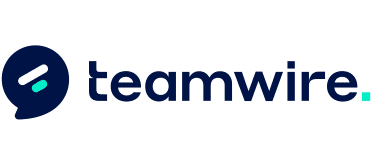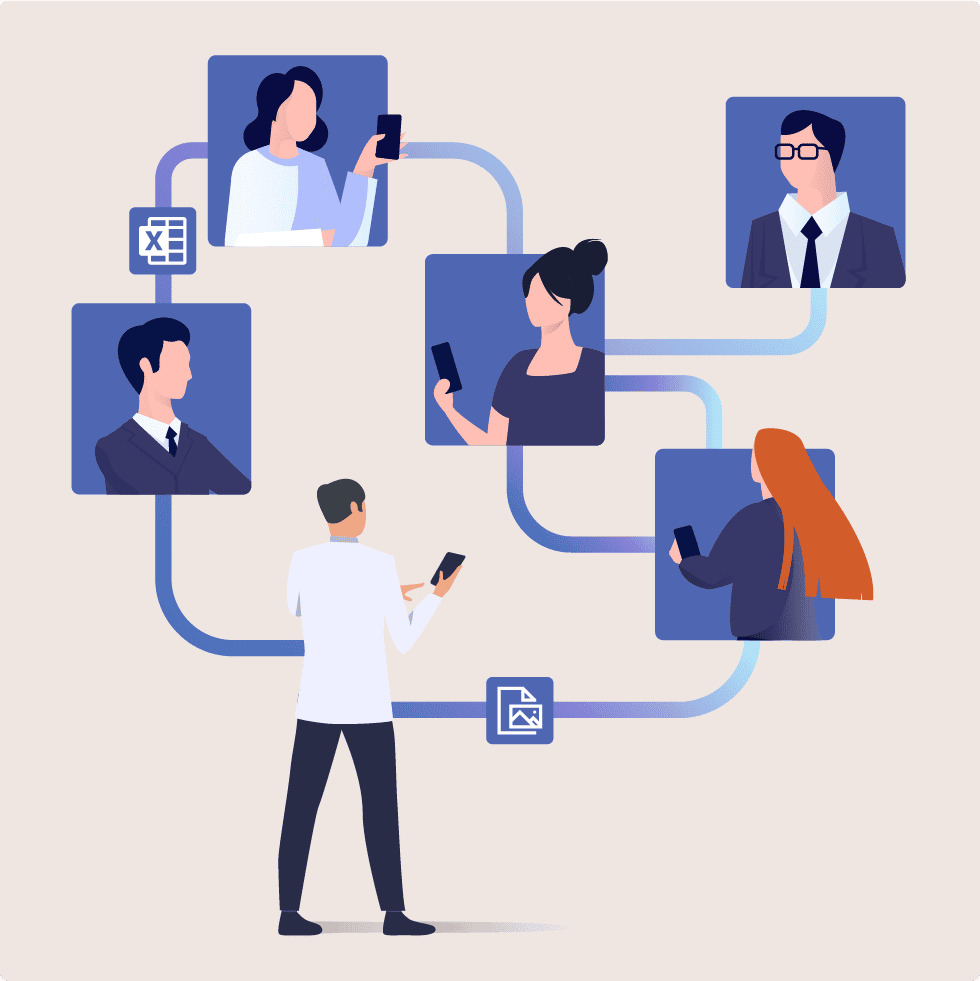Mobile Team Communication – The Essential Standard in Healthcare
Quickly informed, more time for the patient - With our business messaging app solution, we pursue the goal of building bridges in communication in the social and healthcare system. In this blog post, we describe how we approach and achieve this.
The social and healthcare system in Germany is very multi-layered and complex. Many different institutions come together here – from federal ministries and associations to insurance companies, pharmaceutical groups and medical device manufacturers, as even research institutions, service providers and beneficiaries. What can we conclude from such a scope? It means, first, that a not inconsiderable number of medical experts are active in the healthcare sector. And secondly, that communication is the crucial linchpin both in the networking of institutions and in the basic constructs of these.
Let’s focus on the categories “providing services” and “receiving services”:
1. Provide services
Service providers include all healthcare professionals in medical practices, pharmacies, counseling centers, therapy facilities, care centers, nursing homes, hospitals, and clinics. Each of these domains is characterized by different company sizes and corresponding organizational structures. If we take the hospital domain as an example, a possible structural setup could be given by the divisions of medicine, nursing, technology and administration, under which the relevant specialist personnel are affiliated.
2. Receiving services
Beneficiaries are citizens and patients who use the services of a care provider. These may be covered by a single visit to a doctor, for example. However, if we take the example of a patient who visits an orthopedist after twisting his knee, the patient could be sent to a hospital so that an MRI can be performed there. The findings could then be shared with the first provider. If a serious injury were now identified and surgery was deemed unavoidable, the patient could be connected back to the clinic and the appropriate department. After the operation has been completed, the patient could now be provided with convalescence measures, such as physiotherapy.
A productive team communication and collaboration thanks to an uninterrupted flow of communication
To cut to the chase: Every service provider – whether outpatient care services, medical practices or university hospitals – exchanges data, both for internal and external use. Thanks to digitalization, the amount of digital data is growing steadily – but unfortunately, so is the creation of data silos. Referring again to the beneficiary statement and the “MRI diagnostic findings” example, it is standard today to coordinate appointments over the phone and either give the MRI diagnostic findings on DVD to the primary physician or have them sent by courier. The flow of information is ” irregular “. However, every care provider pursues the goal of being able to provide patients with optimal care. To be able to guarantee this, arrangements between mobile staff as well as with colleagues from the administration must take place smoothly without impairing time management, without worsening patient care and without further increasing the burden on the nursing staff. This is because highly sensitive information is often time-critical. For holistic digital team communication in healthcare, a suitable and, above all, GDPR-compliant solution is needed.
Empower mobile workers, avoid shadow IT
Medical providers in particular are characterized by a high proportion of mobile workers. This can include ambulatory care workers, nurses and doctors. In the absence of existing mobile devices such as smartphones, tablets and/or laptops, medical professionals use private devices based on the BYOD concept (Bring your own Device) and resort to consumer apps – most notably WhatsApp – to exchange information about a patient’s findings or get a second opinion from a colleague in a short time. This opens the door for shadow IT. After all, a consumer app is not appropriate for a secure and regulatory-compliant exchange of information in the professional environment – particularly not for medical institutions that work with sensitive personal data. Data protection and security should be an indispensable standard in digital team communication.
The secure WhatsApp alternative
The solution lies in a business messaging app that is a GDPR-compliant WhatsApp alternative. It should not only enable fast and effective exchanges between caregivers, but also be intuitive to use for less tech-savvy people – the very end users. In addition, the solution should be equipped with relevant business functions that are specifically implemented for typical application scenarios in healthcare and the needs of the user groups. This increases user acceptance of the tool and boosts their productivity.
The use of business messaging in healthcare
As complex as the social and healthcare system in Germany is, so are the deployment scenarios. They depend absolutely on the specific needs and necessities of the institutions. However, a nationwide survey by the German Data Protection Institute* shows that messenger services are very widespread in the healthcare sector. 98 percent of the medical doctors surveyed use them.
For this reason, we list the six currently most relevant deployment scenarios that count across service providers and recipients in healthcare:
1. availability of patient data: An open API interface allows third-party systems, such as an electronic patient record (ePA) or hospital information system (HIS), to be connected to the app. This allows data in these systems to be queried, employees to be automatically informed of updates in the patient file, and photos to be stored there.
2. exchange with experts from other institutions and/or service providers: guest accesses are important for integrating external users, such as specialists from other clinics or volunteers, into the communication. Such temporary accesses are under the central control of IT and can be deactivated at any time. In the future, healthcare institutions using the same messenger will be able to communicate with each other.
3. internal exchange among caregivers: If several nurses are caring for a patient, they can discuss general incidents and changes in real time via text and voice messages in patient-specific group chats, for example if the medication dosage has changed. Sharing photos, videos and documents is very helpful in this process. Full encryption and integrated image editing functions ensure the security and anonymity of patient data.
4. alerting in emergency situations: Alerting capabilities are essential to inform selected teams or the entire organization in the event of a critical incident, such as a patient emergency or fire alarm. Acknowledgement functions and read receipts facilitate coordination. A live location feature can transmit the real-time location of caregivers involved. For inpatient stays, an IoT interface connected to a meter or emergency button allows the caregivers in charge to receive the triggered alarm directly to their mobile device.
5. relatives and patients query: With the help of a WhatsApp for Business interface, relatives and patients can communicate with selected persons from healthcare institutions. This makes it easy to make inquiries and quickly obtain information. Patients can also use this interface, for example, to make automated menu queries via chatbots during a hospital stay.
(Learn more about the WhatsApp for Business integration in this blog article).
6. shift changes: If the entire team uses one group chat, handover processes can be easily coordinated. This ensures that all relevant information is passed on in a structured and loss-free manner. Shift schedules can also be managed digitally and shared with colleagues. In addition, logging in and out with different accounts or connecting the app to the UEM system enables multi-user capability, so that several users can use the same mobile device.
A solution for every care service provider
In our intro, we called it the linchpin. Communication – whether internal or external – is key for any healthcare organization to run a successful business, improve the quality of patient care, and keep employees happy. It’s hard to imagine our daily lives without messengers. And if we’re being completely honest, neither is our professional lives anymore. And that’s completely independent of the size of the organization, because as mentioned earlier, every institution has different requirements and use cases. The most important thing here is that every healthcare organization is entitled to secure and intuitive communications. It’s just a matter of using the right business messaging solution to allow all employees, all care providers, and all institutions to enter into direct, real-time communication with each other in a privacy-compliant manner. And that’s what we stand for with Teamwire.
Make use of the Hospital Futures Act (KHZG)
The aim of the KHZG is to promote digitilization and strengthen regional care structures. Read our blog post “Hospital Future Act: How our Business Messenger supports the digitilization of hospitals” to learn how Teamwire contributes to the funding areas of the KHZG and supports the digitilization of your hospital as a central communication hub.
We are here for you
Have you found your use case yet? Or do you question the administrative effort around Teamwire and how our solution can be integrated into your IT infrastructure? Then contact our sales team and arrange a demo appointment.
*Source: https://deutsches-datenschutz-institut.de/wp-content/uploads/2018/04/PM_MessangerimArztalltag_DDI-Deutsches-Datenschutz-Institut_end.pdf

